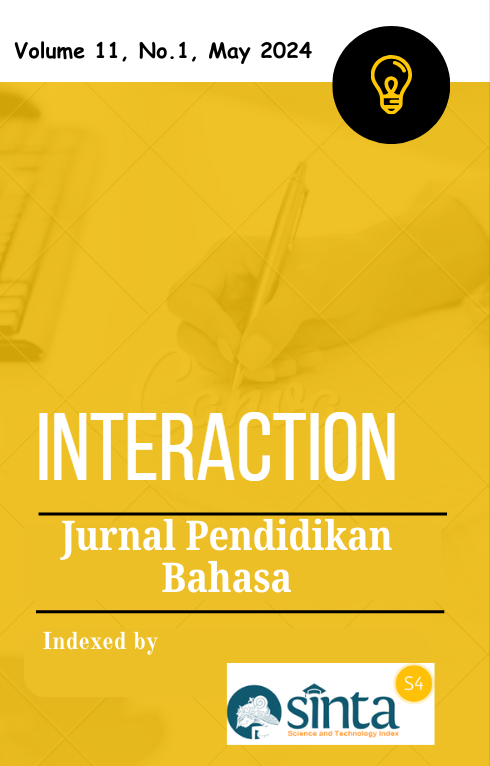English Teacher’s Challenges and Solutions in Teaching Intellectual Disability Students: Case Study
Abstract
English teaching is now inclusive in nature, which means it involves everyone without leaving any one behind. This is also the basis for English language education being everyone's right, including special needs. There is several research on teaching English specifically for disabilities that are very useful for helping teachers' teaching methods, improving strategies, and updating teaching materials. Yet, only a few studies talk about students with intellectual disability. Therefore, the aim of this research is to investigate the English language teaching in the form of challenges and the solutions, this research focused to analyse English teacher’s challenges and solutions in teaching students with mild intellectual disability in SLBN 1 Martapura. Qualitative method is used in this research. To collect the data needed, the observation and interview were done to an English teacher. The finding revealed that the challenges faced by English teacher were challenges in; a) classroom management, b) dealing with students' lack of general cognition, c) overcoming students' lack of focus, d) overcoming students' short memories, e) improving students' English vocabulary pronunciation. Furthermore, the solutions to solve those challenges were by a) using a group learning model, b) choosing fun media and method, c) using concrete objects, 4) using ice breaking, d) references modification, 5) repetition. Thus, English teacher faced many challenges in teaching students with mild intellectual disability. Indeed, there are several previous studies that discuss this issue, however, it is still too little. Thus, the researcher has an urgency to research more so that research for students with intellectual disability is more accommodated.
Downloads
References
Allam, F. C., & Martin, M. M. (2021). Issues and challenges in pecial education: a qualitative analysis from teacher's perspective. Southeast Asia Early Childhood Journal, 10(1), 37-49. https://doi.org/10.37134/saecj.vol10.1.4.2021
Adams, D., Oliver, C. (2011). The expression and assessment of emotions and internal states in individuals with severe or profound intellectual disabilities. Clinical Psychology Review, 31, 293-306. doi: 10.1016/j.cpr.2011.01.003
Dalilan, Sartika, E., Lestari, I. D. (2021). The practices and obstacles of English language teaching in intellectual disability classroom: a case study at special school (SLB) in Palembang. PAYONARA: Journal of English Education, 1(1), 1-18. doi: 10.19105/panyonara.v1i3.4319
Fardila, U. A. (2018). Effective communication for special needs children educators. JARES, 3(2), 20-32. doi: 10.35457/jares.v3i2.491
Fazira, F., I. (2023). The problem faced by teachers in teaching English for intellectual disability students (a case study: English teacher at SLB N Pati). Undergraduate thesis, IAIN, Kudus
Fitria, T., N. (2023). Breaking the ice in the classroom: using ice-breaking in the teaching and learning process. Borneo Journal of English Language Education, 5 (1), 23-38.
Graue, C. (2015). Qualitative data analysis. International Journal of Sales, Retailing & Marketing, 4(9), 5-14.
Greene, & Petty. (1967). Developing Language Skills In The Elementary School. Boston : Allyn And Bacon, Inc.
Gunawan, S., & Saputra, H. (2020). Problems and teaching solutions or students’ in learning Eglish. PROJECT, 3(1). doi: 59-64. 10.22460/project.v3i1.p59-64
Horvat, M. (2000). Physical activity of children with and without mental retardation in inclusive recess settings. Education and Training in Mental Retardation, 35(2), 160-167
Irkinovich, N. R. (2021). The importance of pair work and group work activities
in teaching english in technical universities. МЕЖДУНАРОДНЫЙ ЖУРНАЛ ИСКУССТВО СЛОВА, 4(1-1).
Johnson, B., & Christensen, L. (2000). Educational research: quantitative and qualitative approaches. SAGE Publication, Inc: United States of America.
Jon, R. B., Embong, R., Purnama, B., & Wadi, A. S. (2021). The challenges of English language teaching in Indonesia. International Journal of English and Applied Linguistics (IJEAL), 1(3), 158-168. doi: doi.org/ijeal.v1n1.1157
Jonker, F., Didden, R., Goedhard, L., Korzilius, H., & Nijman, H. (2021). The adaptive ability performance test (ADAPT): a new instrument for measuring adaptive skills in people with intellectual disabilities and borderline intellectual functioning. Journal of Applied Research in Intellectual Disabilities, 34 (4), 1156-1165.
Karuppannan, G., Paramalingam, M., Sultan, F. M. M., & Duari, H. (2021). The effectiveness and the problems faced in the teaching and learning of the English language in a special education classroom in Malaysia. European Journal of Special Education Research, 7(3), 120-128. doi: 10.46827i3.3923.
Ke, Xiaoyan & Liu, J. (2019). Intellectual Disability. Developmental Disorders.
Linusi, Y., Baharuddin, B., & Amin, M. (2022). The problems and challenges English teachers face in taching students with disabilities. Jurnalistrendi: Jurnal Linguistik, Sastra, dan Pendidikan, 7(1): 66-78. doi: 10.51673/jurnalistrendi.v7i1.860
Naghmeh-Abbaspour, B., & Sabokrouh, F. (2020). Training and teaching the interaction of meaning in English classes as foreign languages to students with special needs: A review study. Journal of Critical Reviews, 7 (6), 712-716.
Peraturan Menteri Pendidikan Nasional Republik Indonesia Nomor 16 Tahun 2007 Tentang Standar Kualifikasi Akademik Dan Kompetensi Guru Dengan Rahmat Tuhan Yang Maha Esa Menteri Pendidikan Nasional
Pocaan, J. (2022). Exploring teaching strategies and challenges towards a holistic context-based special education teaching strategies program. The Normal Lights, 16 (1), 168-196.
Rey, J. M., & Martin, A. (2006). JM Rey’s IACAPAP e-textbook of child and adolescent mental health. Lancet.
Damapoli, R. A. P., Tohir, L., & Saputra, A. (2023). An analysis of problems faced by the English teacher in teaching the students with special need at 10th Grade Students of SLBN 1 Mataram (Doctoral dissertation, Universitas Mataram).
Saunders, M. D. (2001). Who’s getting the message? Teaching Exceptional Children, 33, 70-74
Schalock, R. L., Luckasson, R., & Tassé, M. J. (2021). An overview of intellectual disability: Definition, diagnosis, classification, and systems of supports. American journal on intellectual and developmental disabilities, 126(6), 439-442.
Shonkoff, J. P., & Phillips, D. A. (Eds.). (2000). From neurons to neighborhoods: The science of early childhood development. Washington, DC: Committee on Integrating the Science of Early Childhood Development, Board on Children, Youth, and Families, National Academies Press.
Shree, A., & Shukla, P. C. (2016). Intellectual disability: definition, classification, causes and characteristics. Learning Community-An International Journal of Educational and Social Development, 7(1), 9-20. doi: 10.5958/2231-458X.2016.00002.6
Suardi, W. (2017). Catatan kecil mengenai desain kualitatif deskriptif (QD). Jurnal Ekubis, 2 (1), 119-129.
Utami, R. P., Suhardi., Astuti, U. P. (2021). EFL teachers' problems and solutions in teaching English to students with intellectual and developmental disability. Indonesian Journal of English Language Teaching and Applied Linguistics, 6 (1), 173-188. doi: http://dx.doi.org/10.21093 /ijeltal.v6i1.912
Wehman, P. (1997). Exceptional individuals in school, community, and work. Austin, TX: PRO-ED.
Yunisari, P., Kasim, U., & Marhaban, S. (2021). English as a foreign language (EFL) teachers teach English for deaf students. English Education Journal, 12 (2), 337-357. doi: https://doi.org/




.png)



22.png)
